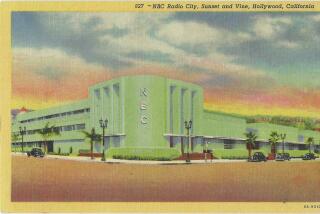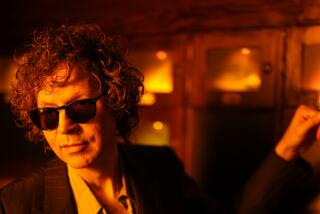Jim Ladd Beats Tribal Drum for FM Rock
The music, the message and the medium all combined to resonate the tribal drum, which kept time for a syncopated movement of new ideas and innocent dreams. FM radio was the soundtrack of our lives.
--Jim Ladd
“Radio Waves: Life and Revolution on the FM Dial,” a book by veteran Los Angeles deejay Jim Ladd, is a 20-year socio-musical odyssey that begins on a high note of youthful idealism and ends with disillusionment and a loss of innocence.
In between are lively tales spun by an avid storyteller about milestones in the development of FM rock radio. The reader is taken back to San Francisco at the height of Flower Power, when the first station signed on, through the heyday of Los Angeles’ own renegade--and now defunct--rocker, KMET.
And who better to tell the story of FM rock’s glory days than the 43-year-old Ladd, currently heard on KLSX-FM (97.1) and a key figure on local radio since 1968?
“I spent 20 years living it and three years writing it,” Ladd said in a recent interview at his hilltop home overlooking Laurel Canyon. “I spent 20 years being called on the general manager’s carpet for speaking my beliefs. I put my heart and soul into this.”
Ladd puts his heart and soul into most things.
The book, which hit bookstores two weeks ago, is pure Ladd, who is known for his on-air verbosity, outspoken political stances and ribald sense of humor.
“I was a stationary minstrel who spun the myths and legends of the tribe in a stream-of-consciousness approach that encouraged the unexpected,” Ladd writes about his start as a deejay. “I had begun my long journey on the path of the shaman. All this from a stack of vinyl and a couple of turntables inside the glass booth.”
The myths and legends revolve around what he calls “the tribal drum,” the musical beacon known as free-form rock radio.
The saga of FM free-form rock began in 1967, as Ladd tells it, spurred on by the mantra of the times: sex, drugs and, of course, rock ‘n’ roll.
“The music of that time was filled with radical new ideas, and a unique generational perspective,” Ladd writes. “Alternative points of view, not heard on the six o’clock news, came through the music loud and clear. Songs about the peace movement, civil rights, Vietnam, drugs, the generation gap--and massive quantities of sex.”
In “Radio Waves,” Ladd recounts staff meetings convened amid the pungent scent of marijuana smoke. And it was not at all uncommon for deejays in those days to conduct their broadcasts under the influence of mind-altering substances.
At a party of KMET deejays at which the station’s outlaw image was forged, Ladd describes the scene in this manner: “The champagne flowed, the joints were rolled and we rocked into the evening.”
Those nights of partying ended abruptly in 1987 for Ladd and his fellow KMET colleagues when the station underwent a radical transformation (or a lobotomy, as Ladd puts it) from a rock format to a New Age soother called “The Wave.”
Although he used some imaginary names to protect identities, most of the radio personalities in Ladd’s book will be familiar to Los Angeles radio listeners. Ladd recounts incidents told to him by colleagues, such as the time when B. Mitchell Reed conducted his KMET midmorning show from his hospital bed just hours after eye surgery, and the period when a madman stalked Mary Turner, another KMET deejay.
His harshest words are reserved for radio consultants, bottom-line station management types and yuppies, whom he feels collectively snuffed out the spirit of FM rock radio.
Ladd clearly misses those days of the tribal rock drumbeat.
“At the same time that FM radio came along was the counterculture, which we don’t have today,” Ladd said, sitting in the comfortable woodsy home where he has lived since the early ‘70s with his wife, Michelle, and a constantly expanding menagerie of pets. (He moved there because it was a stone’s throw from the house immortalized in the song “Love Street,” by his favorite band, The Doors.)
“That explosion of consciousness was so exciting. We felt we were at the front lines and doing battle for the great causes. I miss all the creative energy. . . . I don’t mean to look back and say, ‘Those were the good old days.’ Now we’ve got this great technology, but it’s just a little too slick these days.”
That’s why he wrote this book, he said--not simply to reminisce, but to show his younger listeners what the un-slick golden age of rock radio was all about.
Despite his disillusionment with radio, Ladd returned to the air at KLSX after a two-year hiatus. Prior to that, he was at KEDG-FM (the Edge), a now-defunct alternative rock station that was known for finding new artists and for its eclectic format.
How does it sit with the longtime champion of “renegade rock” to be on a station that most would regard as anything but rebellious or free-form, its format limited to a relatively unadventurous collection of “classic” rock tunes?
“It’s difficult in that part of the mandate of FM radio was to progress. KMET and ‘The Edge’ both prided themselves in finding new bands,” Ladd said. “Yes, I do miss that part of it. However, when I came to work at KLSX I knew I couldn’t expect to play the Black Crowes. It wouldn’t be fair for me to expect that, but I can go home and listen to that.”
Besides, he said, he has been given substantial freedom to run his show as he pleases and his goal is to broaden the station’s parameters “little by little.” Recently, Ladd locked horns with station program director Andy Bloom when he wanted to play “Pocohantas,” a lesser-known Neil Young song, on Earth Day. The song was not on the play list, but Ladd argued that Young is unquestionably a “classic artist” and that that particular cut’s lyrics were perfectly suited to a day devoted to environmental awareness.
He still loves rock ‘n’ roll as much he always did and though he doesn’t knock heads with management quite as violently as he used to, he continues to tilt at windmills.
“The social issues have changed, but I still think there’s a civil rights issue, for instance,” Ladd said. “It’s harder work now, the less glamorous work, the daily personal work. My show doesn’t talk so much at the broad political level, it’s more at an introspective level. . . . It’s not some slick pre-packaged deal. I’m not in show business. I’m in FM radio. I just keep thinking this is supposed to be about the music and what rock ‘n’ roll is trying to say.”
More to Read
The biggest entertainment stories
Get our big stories about Hollywood, film, television, music, arts, culture and more right in your inbox as soon as they publish.
You may occasionally receive promotional content from the Los Angeles Times.










